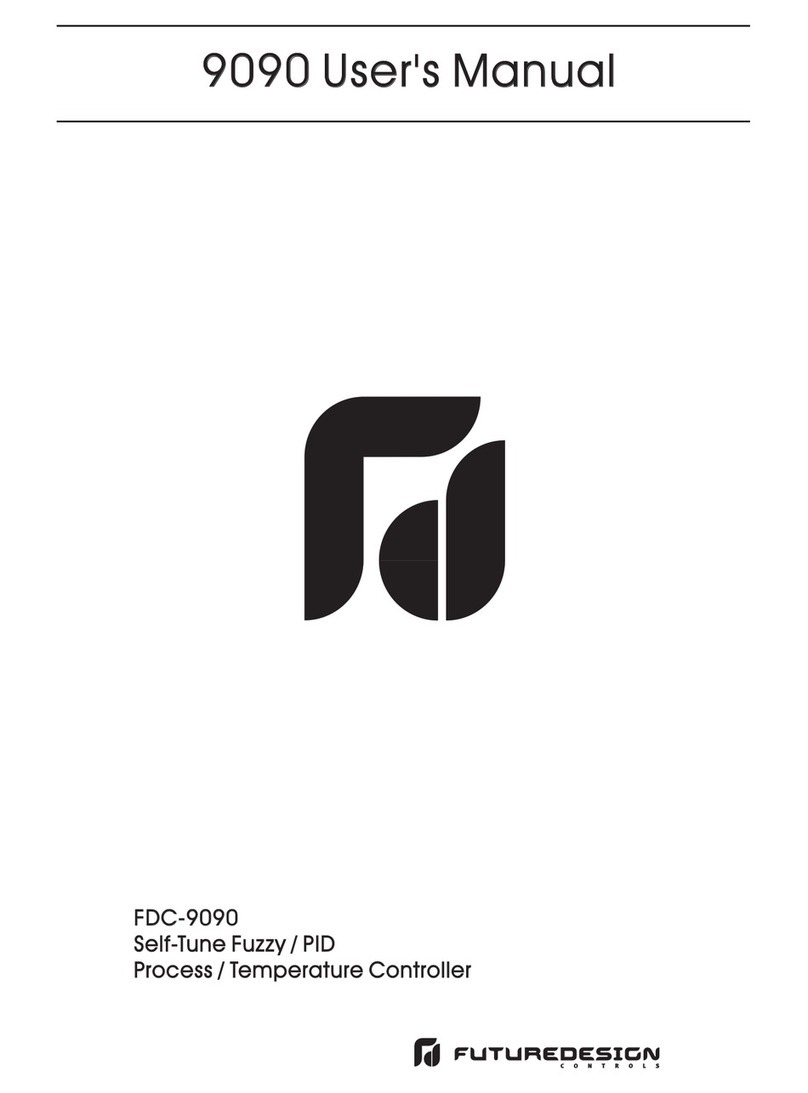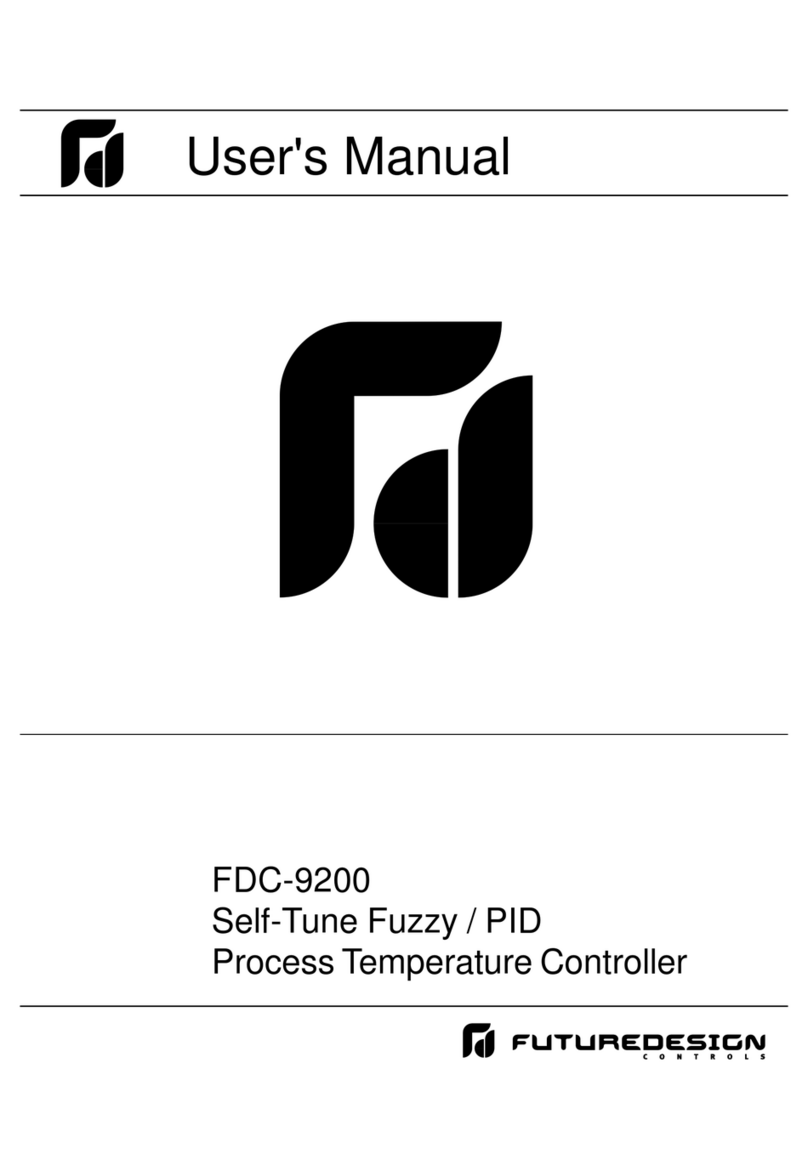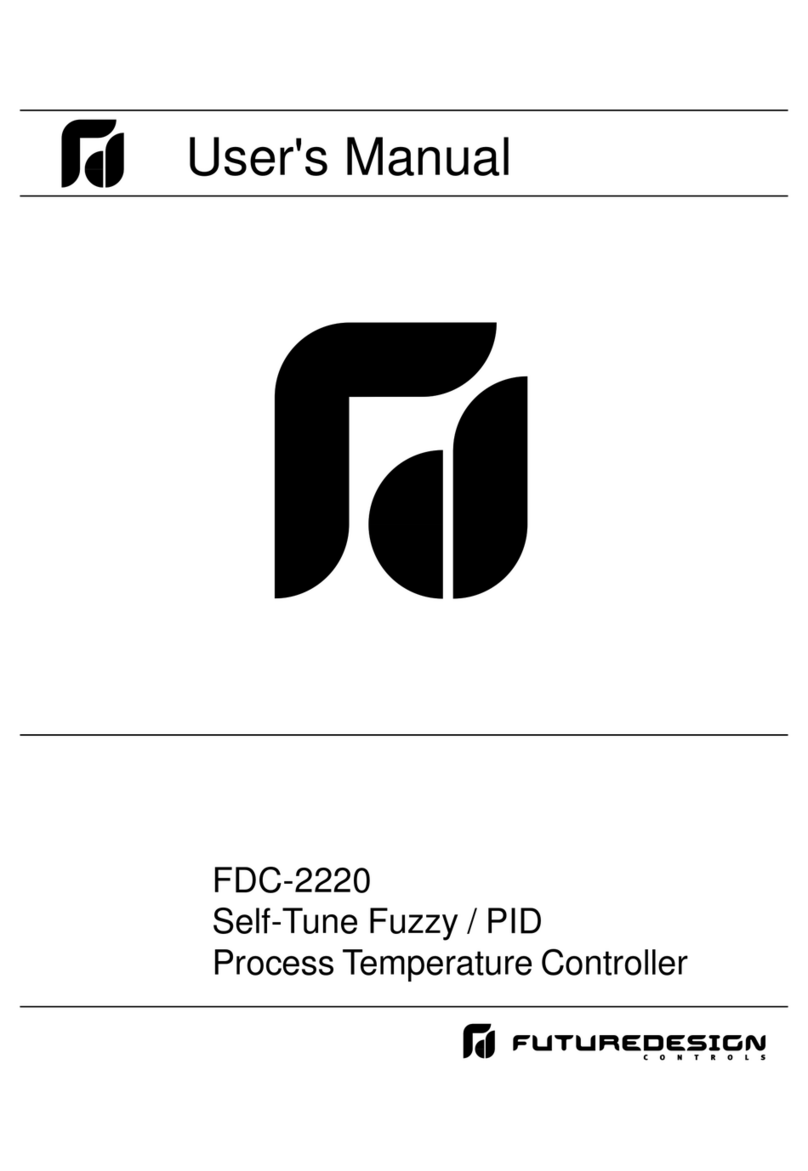
Chapter 1 OverviewChapter 1 Overview
1 1 Features1 1 Features
FDC-9300 Fuzzy Logic plus PID microprocessor-based controller, incorporates a bright,
easy to read 4-digit LED display, indicating process value. The technology
enables a process to reach a predetermined set point in the shortest time, with the
minimum of overshoot during power-up or external load disturbance. The units are
housed in a 1/16 DIN case, measuring 48 mm x 48 mm with 75 mm behind panel
depth. The units feature three touch keys to select the various control and input
parameters. Using a unique function, you can put at most 5 parameters in front of user
menu by using contained in the setup menu. This is particularly useful to
OEM's as it is easy to configure menu to suit the specific application.
Fuzzy Logic
SEL1 to SEL5
FDC-9300 Fuzzy Logic plus PID microprocessor-based controller, incorporates a bright,
easy to read 4-digit LED display, indicating process value. The technology
enables a process to reach a predetermined set point in the shortest time, with the
minimum of overshoot during power-up or external load disturbance. The units are
housed in a 1/16 DIN case, measuring 48 mm x 48 mm with 75 mm behind panel
depth. The units feature three touch keys to select the various control and input
parameters. Using a unique function, you can put at most 5 parameters in front of user
menu by using contained in the setup menu. This is particularly useful to
OEM's as it is easy to configure menu to suit the specific application.
Fuzzy Logic
SEL1 to SEL5
FDC-9300 is powered by 11-28 or 90 - 264 VDC / AC supply, incorporating a 2 amp.
control relay as standard. Up to two additional optional relay outputs can be
supported. Output two can be a cooling relay or alarm or dwell timer.The third relay
performs as a programmable alarm. Alternative output options include SSR Drive,
Triac, 0/4 - 20 mA and 0 - 10 volts. FDC-9300 is fully programmable for PT100,
thermocouple types J, K, T, E, B, R, S, C, P, 0 - 20mA, 4 -20mA and voltage signal input,
with no need to modify the unit. The input signals are digitized by using a
converter. Its allows the FDC-9300 to control fast processes such as
pressure and flow. is incorporated. The self- tune can be used to optimize the
control parameters as soon as undesired control result is observed. Unlike auto-tune,
Self-tune will produce less disturbance to the process during tuning, and can be used
any time.
18-bit A to D
fast sampling rate
Self tune
FDC-9300 is powered by 11-28 or 90 - 264 VDC / AC supply, incorporating a 2 amp.
control relay as standard. Up to two additional optional relay outputs can be
supported. Output two can be a cooling relay or alarm or dwell timer.The third relay
performs as a programmable alarm. Alternative output options include SSR Drive,
Triac, 0/4 - 20 mA and 0 - 10 volts. FDC-9300 is fully programmable for PT100,
thermocouple types J, K, T, E, B, R, S, C, P, 0 - 20mA, 4 -20mA and voltage signal input,
with no need to modify the unit. The input signals are digitized by using a
converter. Its allows the FDC-9300 to control fast processes such as
pressure and flow. is incorporated. The self- tune can be used to optimize the
control parameters as soon as undesired control result is observed. Unlike auto-tune,
Self-tune will produce less disturbance to the process during tuning, and can be used
any time.
18-bit A to D
fast sampling rate
Self tune
Two function complexity levelsTwo function complexity levels
User menu configurableUser menu configurable
Adaptive heat-cool High accuracy 18-bit input A DAdaptive heat-cool High accuracy 18-bit input A D
High accuracy 15-bit output D AHigh accuracy 15-bit output D A
Fast input sample rate (5 times / second)Fast input sample rate (5 times / second)
dead banddead band
Pump controlPump control
Fuzzy + PID microprocessor-based controlFuzzy + PID microprocessor-based control
Automatic programmingAutomatic programming
Differential controlDifferential control
Auto-tune functionAuto-tune function
Self-tune functionSelf-tune function
Sleep mode functionSleep mode function
Unique
Valuable
Unique
Valuable
" Soft-start " ramp and dwell timer" Soft-start " ramp and dwell timer
Programmable inputs( thermocouple, RTD, mA, VDC )Programmable inputs( thermocouple, RTD, mA, VDC )
Analog input for remote set point and CTAnalog input for remote set point and CT
Event input for changing function & set pointEvent input for changing function & set point
Programmable digital filterProgrammable digital filter
Hardware lockout + remote lockout protectionHardware lockout + remote lockout protection
Loop break alarmLoop break alarm
Heater break alarmHeater break alarm
Sensor break alarm + Bumpless transferSensor break alarm + Bumpless transfer
RS-485, RS-232 communicationRS-485, RS-232 communication
Analog retransmissionAnalog retransmission
Signal conditioner DC power supplySignal conditioner DC power supply
A wide variety of output modules availableA wide variety of output modules available
Approvals UR / CSA / CE / RHoS CompliantApprovals UR / CSA / CE / RHoS Compliant
EMC / CE EN50081-1 & EN50082-2EMC / CE EN50081-1 & EN50082-2
Front panel sealed to NEMA 4X & IP65Front panel sealed to NEMA 4X & IP65
The function of Fuzzy Logic is to adjust PID parameters internally in order to make
manipulation output value MV more flexible and adaptive to various processes.
The function of Fuzzy Logic is to adjust PID parameters internally in order to make
manipulation output value MV more flexible and adaptive to various processes.
PID + Fuzzy Control has been proven to be an efficient method to improve the control
stability as shown by the comparison curves below:
PID + Fuzzy Control has been proven to be an efficient method to improve the control
stability as shown by the comparison curves below:
Warm Up Load Disturbance
PID control when properly tuned
PID + Fuzzy control
Set point
Temperature
Time
Figure 1.1 Fuzzy PID
Enhances Control
Stability
Figure 1.1 Fuzzy PID
Enhances Control
Stability
UM9300 2.0UM9300 2.0
3































